In businesses and educational institutions, efficient document management is essential at every level. Two indispensable tools that facilitate precise paper handling are guillotines and trimmers. Understanding their functionalities, histories, and applications can significantly enhance operational efficiency.
What is a Guillotine?
A guillotine, often referred to as a paper guillotine or paper cutter, is a device designed to cut large stacks of paper in a single, swift motion. It features a straight, sharp blade that descends onto the paper, ensuring clean and precise cuts. Commonly found in offices, print shops, and educational settings, guillotines are ideal for tasks requiring the cutting of multiple sheets simultaneously.
Guillotines are valued for their speed and efficiency. By allowing users to slice through dozens or even hundreds of sheets at once, they dramatically reduce the time needed for paper preparation tasks. From making classroom handouts to cutting promotional material, guillotines are a time-saving asset.
What is a Trimmer?
A trimmer, also known as a paper trimmer or rotary trimmer, is designed for precision cutting of individual sheets or small stacks of paper. Unlike guillotines, trimmers use a sliding or rotary blade that moves along a rail to make the cut. This design allows for detailed and accurate trimming, making trimmers popular in crafting, photography, and tasks needing meticulous cuts.
Trimmers provide the added advantage of safety and accuracy. With less force needed and a fully enclosed blade in most models, they are perfect for classrooms, design departments, and environments where safe and precise cuts are needed.
How Do Guillotines Work?
Guillotines operate through a lever mechanism. The user lifts the blade arm and then brings it down forcefully onto the paper stack positioned on the cutting base. A clamp or paper guide often holds the paper in place to prevent shifting, ensuring a straight cut. The sharpness of the blade and the leverage provided by the arm enable the guillotine to cut through large stacks effortlessly.
In modern guillotines, features such as laser guides and safety shields have enhanced usability and safety. Many models also include an adjustable backstop to allow consistent, repeatable cuts.

The History and Development of Guillotines and Trimmers
The evolution of paper cutting tools dates back to the mid-19th century. French inventor Guillaume Massiquot patented the first paper cutter in 1844, laying the foundation for modern guillotines. Later enhancements were made by innovators like Milton Bradley, who patented his version in 1879. These early designs have since evolved, incorporating safety features and precision enhancements to meet contemporary needs.
Trimmers, particularly rotary trimmers, appeared later as the demand for precise, single-sheet cutting grew. Their design focuses on accuracy, catering to specialised tasks in photography, crafting, and architectural design. Over time, trimmers have become lighter, more compact, and safer, making them accessible for everyday office and classroom use.
Key Components of Guillotines and Trimmers
Understanding the components of these tools aids in their effective utilisation:
Guillotines:
- Blade Arm: The lever that houses the cutting blade.
- Cutting Blade: A sharp, straight-edged blade responsible for making the cut.
- Cutting Base: The flat surface where paper is placed, often marked with measurement guides.
- Paper Clamp: A mechanism that holds the paper stack firmly to prevent movement during cutting.
- Safety Latch: Locks the blade when not in use to prevent accidental injuries.
Trimmers:
- Rotary Blade: A circular blade that slides along a rail to execute cuts.
- Cutting Rail: The track along which the rotary blade moves.
- Cutting Base: A flat surface with measurement guides for precise alignment.
- Paper Guide: Helps in aligning paper for consistent cuts.
- Safety Shield: Covers the blade to protect users during operation.
Tasks Best Suited for Guillotines
Guillotines excel in scenarios requiring the cutting of multiple sheets or thick materials simultaneously. They are ideal for:
- Bulk Paper Cutting: Preparing large quantities of handouts or documents.
- Trimming Cardstock: Cutting thicker materials used in presentations or covers.
- Standardised Cuts: Ensuring uniformity across multiple copies.
- Booklets and Brochures: Guillotines are useful in print shops for creating uniform edges on multi-page documents.
Their robust design allows for handling large workloads efficiently, especially in high-demand environments.
Tasks Best Suited for Trimmers
Trimmers are designed for precision and are best suited for:
- Photograph Cropping: Achieving exact dimensions without damaging the photo.
- Detailed Crafting: Cutting intricate shapes or lines in paper crafts.
- Single-Sheet Adjustments: Making minor modifications to individual documents.
- Classroom Use: Ideal for art projects, trimming posters, or resizing worksheets.
The accuracy of trimmers makes them indispensable for tasks where detail is paramount. Their intuitive design also allows for ease of use among students and non-specialist staff.
How to Sharpen a Guillotine Blade
Maintaining a sharp blade is crucial for the optimal performance of a guillotine. While professional sharpening services are recommended, minor touch-ups can be performed using honing tools or sharpening stones.
To sharpen the blade manually:
- Remove the blade according to the manufacturer’s instructions.
- Use a sharpening stone or honing steel, holding the blade at the correct angle (typically 20-30 degrees).
- Stroke the blade evenly along the stone.
- Test the sharpness by cutting a single sheet of paper.
It’s essential to follow manufacturer guidelines and prioritise safety during the sharpening process. Regular maintenance not only improves cutting efficiency but also extends the lifespan of the equipment.
Safety Tips and Best Practices
Using guillotines and trimmers safely is paramount in any setting. Here are a few tips:
- Always engage the safety latch when not in use.
- Keep hands away from the cutting edge, using guides and clamps instead.
- Use on a stable, flat surface to prevent movement.
- Ensure blades are sharp to reduce the need for excess force.
- Store trimmers and guillotines in designated areas, out of reach of small children.
Guillotines and trimmers are more than just cutting tools – they’re all but essential when you’re preparing large document runs or crafting detailed visuals. Understanding the strengths of guillotines and trimmers can help you choose the right solution for your needs.
By investing in the right equipment and maintaining it properly, businesses and educational facilities can enjoy smoother operations, cleaner results, and a safer environment for all users.

